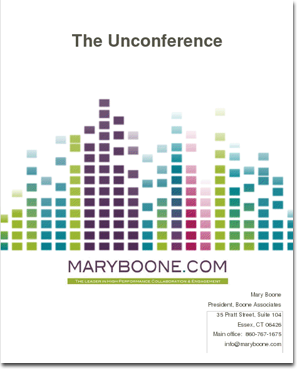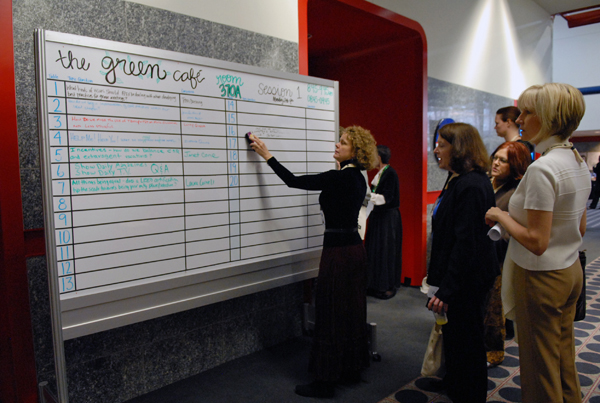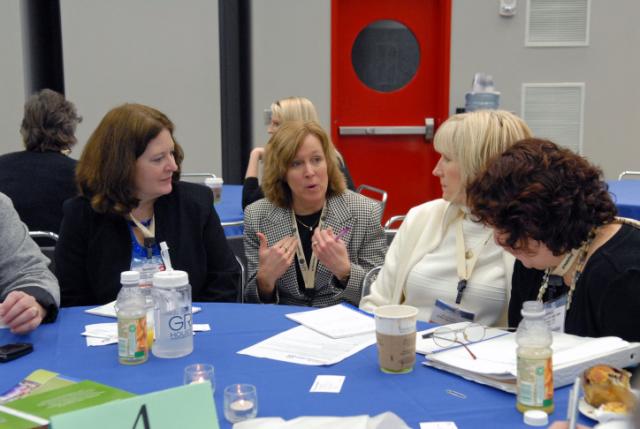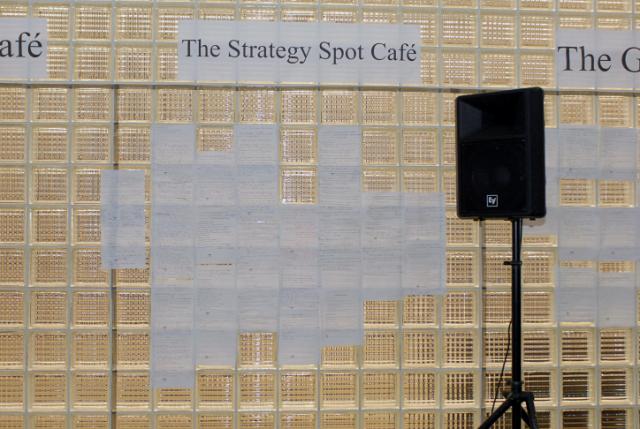Click here to view a short video clip that was shown during the Opening General Session of Meeting Professionals International’s 2008 MeetDifferent event in Houston, TX. The purpose of the clip was to provide participants guidance for navigating the unconference experience Mary designed and facilitated at the event.

Imagine your next conference has only a handful of speakers, no tables, and no preset agenda. Sounds like chaos, doesn’t it? Prepare to be surprised.
A phenomenon that has been quietly growing for years in the organizational development community is starting to hit prime time with conference planners and participants. Variously called Large Group Methods, Mega-conversations, and Unconferences – these approaches to maximizing interaction and minimizing preset meeting structure are starting to infiltrate meetings of all types.
The unconference might seem to be of questionable value at first glance. Isn’t an “unconference” just a cute gimmick or a passing fad? Why should you care about them?
#1 Unconferences increase engagement. When people build ideas together they get excited about them and put them into action.

#2 The increase in interactive approaches to work is driving the need for more interactive meetings. People expect to interact with each other and with speakers at meetings – especially younger audiences accustomed to online interaction. Unconferences offer unprecedented levels of interactivity.

#3 Unconferences can produce very creative and innovative ideas that deliver measurable results.

You’ve probably heard of Open Space – a frequently used method for unconferences. In Open Space, participants design the agenda, choose how they will spend their time and generate a report that encapsulates the learnings of the group. What appears to be a very unstructured approach is, in fact, very orderly and productive because it is based on principles of self-organization. What that means is that with a few simple rules, a group will do much of the organizing of a conference on its own, without heavy direction from planners or senior executives.
Meeting professionals can be instrumental in helping to determine when an unconference makes sense. An unconference can stand alone or be part of another conference. Good meeting design can help you determine where and how the concept of the unconference fits. (For more information, see the article “The Art of Meeting Design”, Successful Meetings, December 2006).
Second, you can play a key role in helping senior executives to understand why and how the principles of the unconference work. An unconference taps into the collective wisdom and creativity of a group in a highly engaging and productive way. However, many executives will be understandably concerned about issues of power and control when opening up the meeting to the group and it will be your job to show them how giving up a bit of control of the meeting can unleash enormous amounts of creativity and innovation and also build true ownership of ideas and plans.
Third, setting up for an unconference is not trivial. Room and site selection, set up of props, selection of facilitators, coordination of pre-meeting communication, and design of follow-on interaction are just a few of the things a meeting planner will need to attend to.
My own experiences designing and facilitating unconferences include working with both for-profit and non-profit organizations in a wide variety of settings. Sometimes I use technology to enhance the interaction and sometimes it’s just good face-to-face conversation that makes the approach work. Regardless of what methods you use, the most important thing is to start with a good understanding of what you want to accomplish with the interaction. One unconference I designed resulted in 3000 people being able to share a variety of new approaches to cross-selling in a space of just a few hours. At the end of the session over 1000 volunteered to work on project teams to bring the top 3 ideas to fruition.
Kaliya Hamlin co-produces and facilitates meetings called “Internet Identity Workshops” using an unconference approach. She says, “In technical communities where innovation and interoperability are key to the success of all vendors – [unconferences] have been particularly powerful because you have to build trust between the parties involved.” Hamlin believes the unconference approach was critical in enabling this group to collaborate effectively on an industry standard called “Open ID” – despite the enormous diversity of the organizations involved. She attributes a number of innovations and breakthroughs in this collaborative effort to use of unconferences.
Don’t look for an end to keynote speakers or planned activities at your conferences. There will always be room for unique ideas that inspire and for carefully planned interactions. But conference participants, both now and increasingly in the future, will expect to play a key role in what happens at your meetings. You can channel that energy and enthusiasm with an unconference.